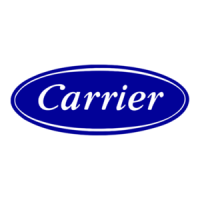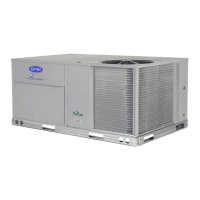5
Check the condition of the motor pulley for signs of wear. Glazing
of the belt contact surfaces and erosion on these surfaces are signs
of improper belt tension and/or belt slippage. Pulley replacement
may be necessary.
To change fan speed:
1. Shut off unit power supply.
2. Loosen belt by loosening fan motor mounting nuts. (See
Fig. 5.)
3. Loosen movable pulley flange setscrew. (See Fig. 6.)
4. Screw movable flange toward fixed flange to increase speed
and away from fixed flange to decrease speed. Increasing fan
speed increases load on motor. Do not exceed maximum
speed specified.
5. Set movable flange at nearest keyway of pulley hub and
tighten setscrew to torque specifications.
To align fan and motor pulleys:
1. Loosen fan pulley setscrews.
2. Slide fan pulley along fan shaft. Make angular alignment by
loosening motor from mounting.
3. Tighten fan pulley setscrews and motor mounting bolts to
torque specifications.
4. Recheck belt tension.
Fig. 6 — Supply-Fan Pulley Adjustment
BEARINGS
This fan system uses bearings featuring concentric split locking
collars. The collars are tightened through a cap screw bridging the
split portion of the collar. The cap screw has a Torx T25 socket
head. To tighten the locking collar: Hold the locking collar tightly
against the inner race of the bearing and torque the cap screw to
65 to 70 in-lb (7.4 to 7.9 Nm). See Fig. 7.
Fig. 7 — Tightening Locking Collar
MOTOR
When replacing the motor, also replace the external-tooth lock
washer (star washer) under the motor mounting base; this is part of
the motor grounding system. Ensure the teeth on the lock washer
are in contact with the motor’s painted base. Tighten motor
mounting bolts to 120 ± 12 in-lb.
Changing fan wheel speed by changing pulleys: The horsepower
rating of the belt is primarily dictated by the pitch diameter of the
smaller pulley in the drive system (typically the motor pulley in
these units). Do not install a replacement motor pulley with a
smaller pitch diameter than provided on the original factory pul-
ley. Change fan wheel speed by changing the fan pulley (larger
pitch diameter to reduce wheel speed, smaller pitch diameter to in-
crease wheel speed) or select a new system (both pulleys and
matching belt(s)).
Before changing pulleys to increase fan wheel speed, check the
fan performance at the target speed and airflow rate to determine
new motor loading (bhp). Use the fan performance tables or use
the Packaged Rooftop Builder software program. Confirm that the
motor in this unit is capable of operating at the new operating con-
dition. Fan shaft loading increases dramatically as wheel speed is
increased.
To reduce vibration, replace the motor’s adjustable pitch pulley
with a fixed pitch pulley (after the final airflow balance adjust-
ment). This will reduce the amount of vibration generated by the
motor/belt-drive system.
COOLING
Condenser Coil
The condenser coil is fabricated with round tube copper hairpins
and plate fins of various materials and/or coatings (see
Appendix A to identify the materials provided in this unit). The
coil may be one-row or composite-type two-row. Composite two-
row coils are two single-row coils fabricated with a single return
bend end tubesheet.
Condenser Coil Maintenance and Cleaning
Recommendation
Routine cleaning of coil surfaces is essential to maintain proper
operation of the unit. Elimination of contamination and removal of
harmful residues will greatly increase the life of the coil and ex-
tend the life of the unit. The following maintenance and cleaning
procedures are recommended as part of the routine maintenance
activities to extend the life of the coil.
REMOVE SURFACE LOADED FIBERS
Surface loaded fibers or dirt should be removed with a vacuum
cleaner. If a vacuum cleaner is not available, a soft non-metallic
bristle brush may be used. In either case, the tool should be ap-
plied in the direction of the fins. Coil surfaces can be easily dam-
aged (fin edges can be easily bent over and damage to the coating
of a protected coil) if the tool is applied across the fins.
NOTE: Use of a water stream, such as a garden hose, against a
surface loaded coil will drive the fibers and dirt into the coil. This
will make cleaning efforts more difficult. Surface loaded fibers
STRAIGHT EDGE
MUST BE PARALLEL
WITH BELT
SETSCREWS
MOTOR AND
FANSHAFTS
MUST BE
PARALLEL
FIXED FLANGE
MOVABLE
FLANGE
SINGLE - GROOVE
FAN PULLEY
MOTOR PULLEY
T --- 2 5 T O R X S O C K E T
HEAD CAP SCREW
LOCKING COLLAR
WARNING
UNIT OPERATION AND SAFETY HAZARD
Failure to follow this warning could cause personal injury,
death and/or equipment damage.
This system uses R-410A refrigerant, which has higher pres-
sures than R-22 and other refrigerants. No other refrigerant
may be used in this system. Gage set, hoses, and recovery sys-
tem must be designed to handle R-410A refrigerant. If unsure
about equipment, consult the equipment manufacturer.

